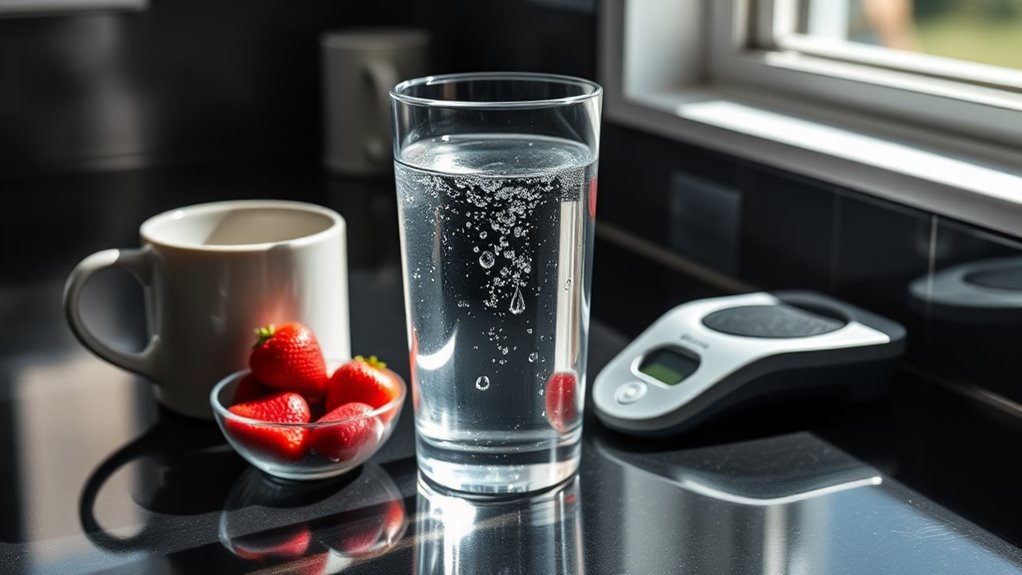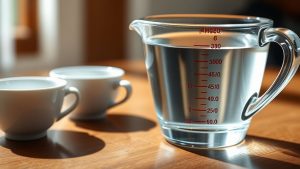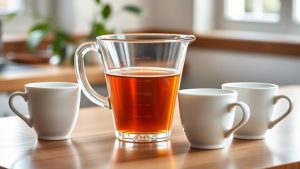
Eight ounces is equivalent to 1 cup in U.S. measurements, which you'd see as a filled drinking glass or measuring cup. This measurement is essential for accurate hydration and cooking. For liquids like water or broth, it's exactly 8 fluid ounces, weighing the same. You might encounter this familiar portion in recipes or beverage containers, helping you gauge your daily consumption effectively. If you keep exploring, you'll discover more insights on fluid measurements and their implications.
When you think about everyday measurements, 8 fluid ounces often comes to mind, especially in cooking and hydration. This volume is equivalent to 1 cup in U.S. standard measurements, making it a fundamental metric that you encounter frequently in recipes and daily fluid intake guidelines. Understanding how 8 fl oz fits into these contexts can enhance your cooking precision and help you maintain proper hydration.
8 fluid ounces, or 1 cup, is a key measurement in cooking and hydration, essential for precision and daily intake.
In the kitchen, you'll often find that recipes use fluid ounces or cups to measure liquid ingredients. For example, broth for a soup or water for a sauce may require you to measure out 8 fl oz. Since 1 cup equals 8 fluid ounces, this measurement plays a significant role in balancing flavors and textures. It's essential to recognize that when measuring, using a liquid measuring cup guarantees accuracy, as these cups are designed to provide a clear view of the fill level. Always remember to check the measurement at eye level for the best precision. Liquid measuring cups are specifically designed for measuring liquids, ensuring you achieve the correct volume.
Hydration is another area where 8 fl oz becomes significant. The common recommendation is to drink eight 8-ounce glasses of water a day, totaling 64 ounces. However, this guideline can vary based on individual needs, including factors like body weight, activity level, and climate. For some, total daily fluid intake recommendations range from 72 to 104 ounces, depending on gender and age. As such, while 8 fl oz is a standard serving size, it's imperative to listen to your body and adjust your intake accordingly.
When considering the weight of 8 fluid ounces, it's useful to know that when measuring water, the volume and weight correspond directly—8 fl oz of water weighs 8 ounces. However, this relationship can change with different liquids due to their varying densities. For instance, denser liquids like honey will weigh more than 8 ounces for the same volume, while oils will weigh less. This distinction is significant when following recipes that involve diverse liquid ingredients.
In practice, you might also use 8 fl oz as a reference point for common beverage containers. Many standard drinking glasses hold between 8 to 12 ounces, offering a convenient serving size for beverages like juice or coffee. In this sense, understanding what 8 fl oz looks like can help you gauge how much you're consuming throughout the day.
Finally, employing the right measurement tools is essential. Liquid measuring cups, which are typically made of glass or clear plastic, are ideal for guaranteeing accurate measurements of liquids. When you use these tools, you'll find it easier to keep your measurements consistent, so your culinary creations turn out just as you expect them to.
Don't forget the significance of the tare function on scales if you're measuring multiple ingredients in one container, and always trust your visual cues like the meniscus for the best results.
Conclusion
In everyday terms, 8 ounces is akin to a cup of coffee or a standard water bottle, bringing clarity to portion sizes. Picture holding a medium-sized apple or a small handful of nuts—these visual cues help you grasp what 8 oz truly represents. Understanding this measurement enhances your cooking and nutrition skills, letting you navigate recipes and dietary guidelines with ease. Just like a painter needs the right brush, knowing these measurements equips you for culinary success.



